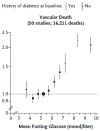Prediabetes: a high-risk state for diabetes development
- PMID: 22683128
- PMCID: PMC3891203
- DOI: 10.1016/S0140-6736(12)60283-9
Prediabetes: a high-risk state for diabetes development
Abstract
Prediabetes (intermediate hyperglycaemia) is a high-risk state for diabetes that is defined by glycaemic variables that are higher than normal, but lower than diabetes thresholds. 5-10% of people per year with prediabetes will progress to diabetes, with the same proportion converting back to normoglycaemia. Prevalence of prediabetes is increasing worldwide and experts have projected that more than 470 million people will have prediabetes by 2030. Prediabetes is associated with the simultaneous presence of insulin resistance and β-cell dysfunction-abnormalities that start before glucose changes are detectable. Observational evidence shows associations between prediabetes and early forms of nephropathy, chronic kidney disease, small fibre neuropathy, diabetic retinopathy, and increased risk of macrovascular disease. Multifactorial risk scores using non-invasive measures and blood-based metabolic traits, in addition to glycaemic values, could optimise estimation of diabetes risk. For prediabetic individuals, lifestyle modification is the cornerstone of diabetes prevention, with evidence of a 40-70% relative-risk reduction. Accumulating data also show potential benefits from pharmacotherapy.
Copyright © 2012 Elsevier Ltd. All rights reserved.
Conflict of interest statement
We declare that we have no conflict of interest.
Figures



Comment in
-
Prediabetes and the risk of diabetes.Lancet. 2012 Oct 6;380(9849):1225; author reply 1226. doi: 10.1016/S0140-6736(12)61705-X. Lancet. 2012. PMID: 23040849 No abstract available.
-
Prediabetes and the risk of diabetes.Lancet. 2012 Oct 6;380(9849):1225-6; author reply 1226. doi: 10.1016/S0140-6736(12)61706-1. Lancet. 2012. PMID: 23040850 No abstract available.
-
Prediabetes and the risk of diabetes.Lancet. 2012 Oct 6;380(9849):1225; author reply 1226. doi: 10.1016/S0140-6736(12)61704-8. Lancet. 2012. PMID: 23040851 No abstract available.
References
-
- World Health Organization, International DF. Definition and diagnosis of diabetes mellitus and intermediate hyperglycaemia: report of a WHO/IDF consultation. Geneva: World Health Organization; 2006.
-
- Balion CM, Raina PS, Gerstein HC, et al. Reproducibility of impaired glucose tolerance (IGT) and impaired fasting glucose (IFG) classification: a systematic review. Clin Chem Lab Med. 2007;45:1180–5. - PubMed
-
- Age- and sex-specific prevalences of diabetes and impaired glucose regulation in 13 European cohorts. Diabetes Care. 2003;26:61–9. - PubMed
Publication types
MeSH terms
Substances
Grants and funding
LinkOut - more resources
Full Text Sources
Other Literature Sources
Medical

